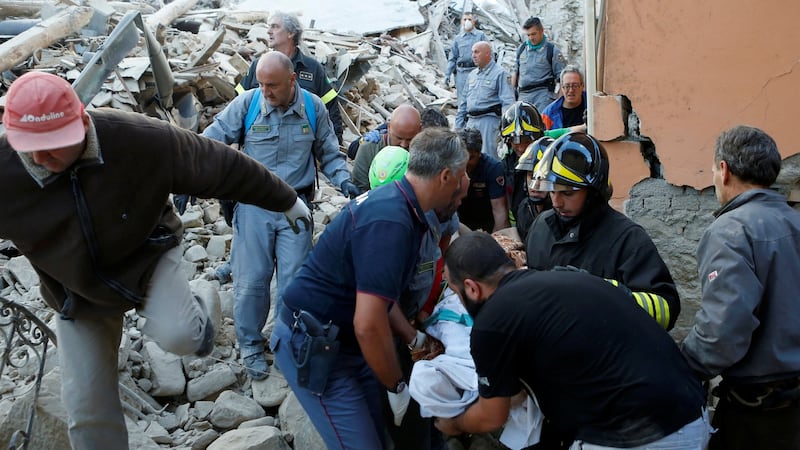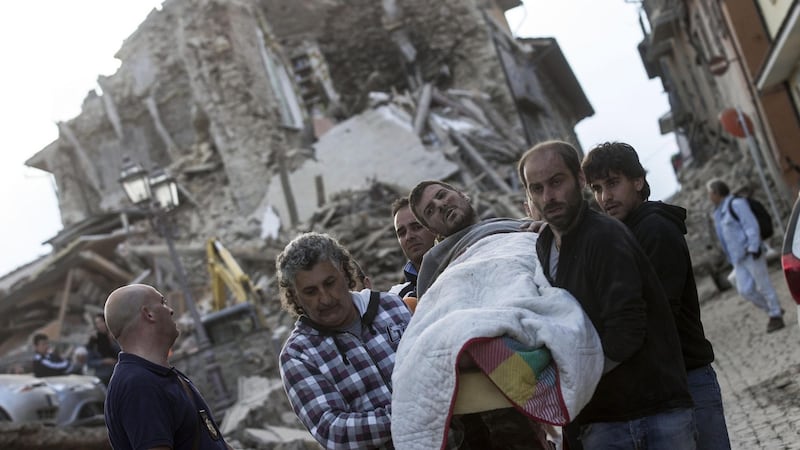Central Italy has been struck by a massive earthquake, registering 6.2 on the Richter scale, with at least 159 people believed killed and many missing.
Rescue crews using bulldozers and their bare hands raced to dig out survivors following a strong earthquake that has reduced three central Italian towns to rubble.
Given that the earthquake has affected a large zone across the regions of Lazio, Abruzzo, Le Marche and Umbria, it is expected that the death toll will rise.


The death toll from an earthquake in central Italy has risen to 120, prime minister Matteo Renzi confirmed.
The earthquake struck at 3.36am with its epicentre in Accumoli, Rieti, about 70km north of Rome.
One small town, Amatrice, appears to have been particularly badly hit, with Mayor Sergio Pirozzi telling Italian radio on Wednesday morning “half the town doesn’t exist any more”.
In the immediate aftermath of the quake, rescue workers and town citizens were digging with their hands in an attempt to find bodies in the rubble.
The initial rescue was improvised as people worked in the darkness in a chaotic situation made dangerous both by people running out onto the streets in panic and also by at least one serious gas leak in Amatrice.
The earthquake has struck in an area already infamous for its seismic instability since more than 300 people lost their lives in a 2009 earthquake in the central Italian city of L’Aquila, 50km south of Amatrice.
Prior to that, 11 people died in a 1997 earthquake in Umbria, a quake which also did serious damage to the Basilica of San Francesco in Assisi.
Unlike the L’Aquila earthquake, which had been preceded by months of mild seismic activity in the area, there had been no warning about this latest strike, which struck 4km below ground.
The European Mediterranean Seismological Centre put the magnitude at 6.1, saying that the epicentre was around Rieti.
Mayor Pirozzi said that not only were there still people “under the rubble” but also that his town had been hit by a landslide while at least one bridge was in danger of collapsing.
For the time being, the Civil Protection agency can only report “severe damage” whilst fire services in the quake zone are reporting unspecified numbers of “victims”.
One Umbrian woman, Lina Mercantini of Ceselli, told Reuters: “It was so strong. It seemed the bed was walking across the room by itself with us on it.”
Other residents in the zone spoke of walls creaking and books falling off the shelves as the 20 second long tremor hit.
Irish Times journalist Justin Comiskey said he felt the quake from a fourth floor apartment in the Serpentara neighbourhood of Rome, about 70km from the epicentre, where he was holidaying with his family. He said the tremor was so strong that it threw his daughter from her bed.
“At 3.37am it shook, and shook so hard that one of my daughters was shook off her bed. The furniture was rattling, there were people running outside on the street below. It was about 20 seconds long, the first one that we felt, and it was really scary stuff.
“I’ve felt earthquakes before in Rome, because I’ve been coming here for 20 years, but there is something about the geology of Rome-it’s built on a rock called tufo that has holes in it so an earthquake simply passes through it, it meets no resistance and it sort of dissipates the power of an earthquake locally and moves it on.
“So I was thinking of this when we felt the earthquake last night and it was way stronger than anything that I’ve felt in Rome before and when it was over I turned to my wife and said ‘I’m sure some people have just died’. It was frightening.
“There was another one about an hour later. Again the bed was moving forwards and back but not at the same power as the first one. Once you feel the first earthquake you’re on alert for aftershocks.”
Italian Prime Minister Matteo Renzi’s spokesman confirmed the government was following the situation closely, in collaboration with the civil protection agency.









